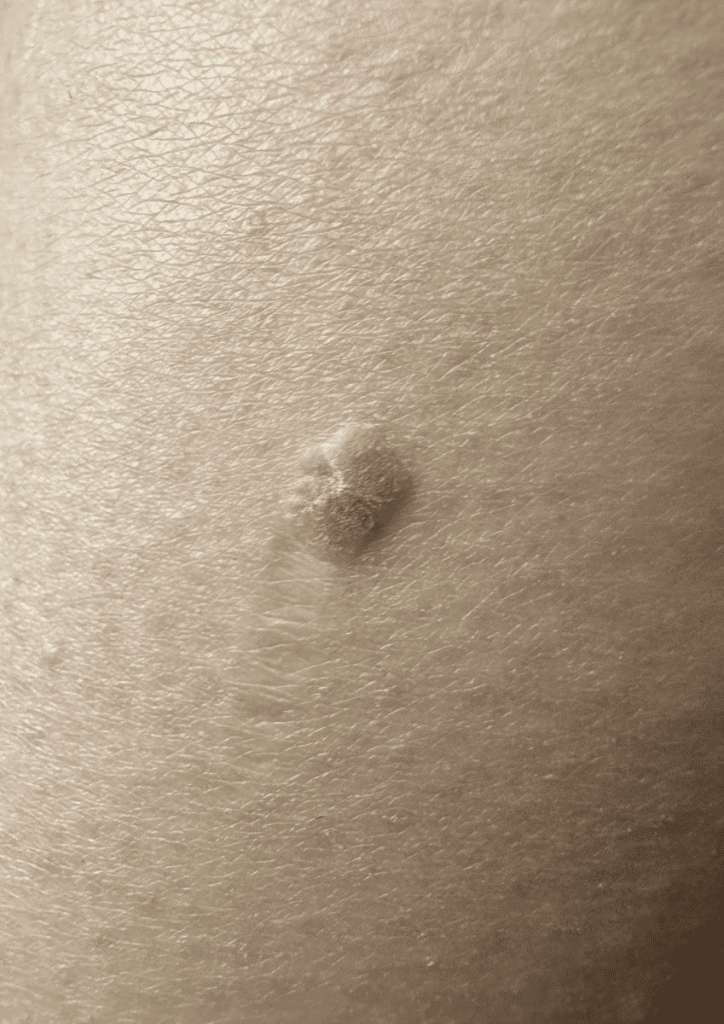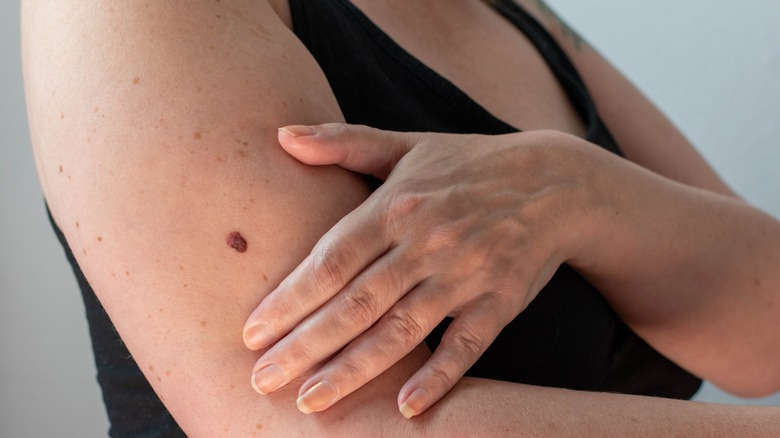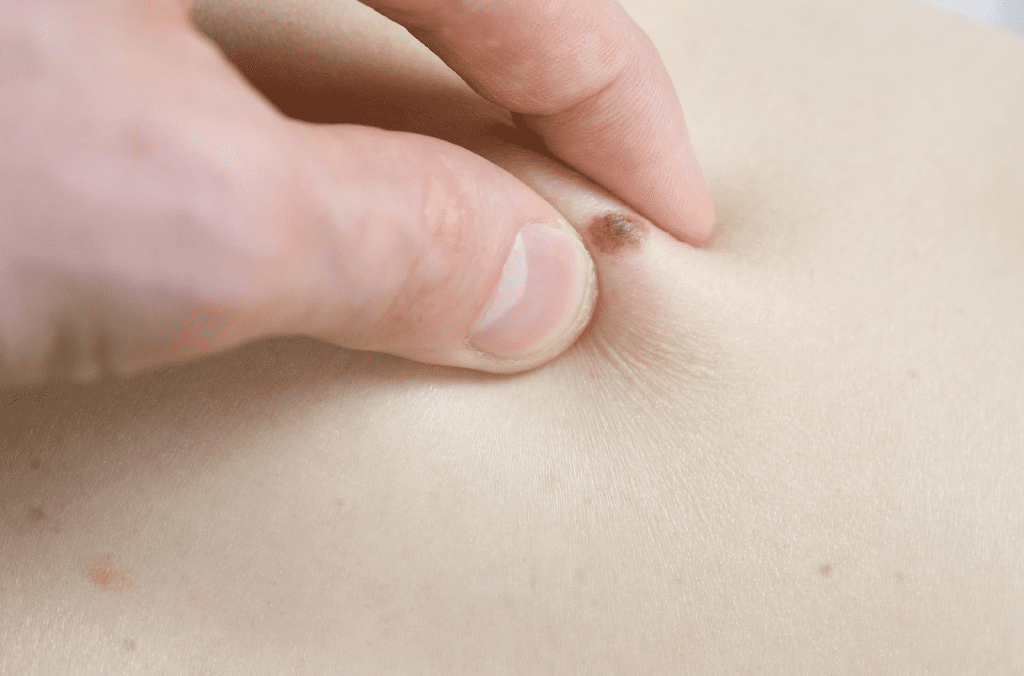Moles are common skin features that most of us have scattered across our bodies. While many of these moles remain unchanged over time, it’s natural to feel concerned if you notice one that has altered in appearance, particularly if it has developed a crusty texture. Changes in moles can be alarming, especially given the rising awareness of skin cancer. In this article, we’ll explore what it means when a mole looks crusty and when it’s time to consult a healthcare professional.

What Are Moles and How Do They Form?
Moles, also known as nevi, are small, pigmented skin growths composed of melanocytes, the cells responsible for producing skin pigment. These growths vary in color, ranging from brown to black, and can appear anywhere on the skin. Most people develop between 10 and 40 moles throughout their lifetime, often during childhood or adolescence.
For the most part, moles are harmless and don’t change much. However, factors like sun exposure, hormonal shifts, or the potential onset of skin cancer can cause some moles to evolve in size, shape, or texture. When a mole starts to crust, bleed, or change color, it’s important to take note, as these could be early warning signs of a more serious condition.
The ABCDEs of Moles: Key Indicators to Watch For
Dermatologists use the “ABCDE” rule to help people monitor moles for signs of potential skin cancer, particularly melanoma. Here’s what each letter stands for:
- A – Asymmetry: A healthy mole is generally symmetrical. If one half of the mole looks different from the other, this could be a sign that something’s wrong.
- B – Border: Look at the edges of your mole. Smooth, even borders are typically harmless, but jagged, blurred, or irregular edges might warrant further examination.
- C – Color: Moles should usually be one consistent color. If a mole contains multiple colors or appears blue, white, or red in addition to its usual brown or black, it’s worth getting checked.
- D – Diameter: Moles larger than 6mm (about the size of a pencil eraser) are more likely to pose problems, especially if they keep growing.
- E – Evolution: Perhaps the most important sign. If a mole changes in size, shape, color, or texture—or if it starts to crust, bleed, or itch—this could be an indicator of melanoma or another skin condition.
Why Is My Mole Crusty?

A crusty mole can undoubtedly cause concern, but it’s crucial to understand that not every crusty mole is malignant. There are a few reasons why a mole might develop a crusty surface:
- Irritation: Moles can become irritated from friction caused by clothing or scratching. Physical trauma to the mole can lead to scabbing or crusting.
- Dry Skin: If the surrounding skin is dry or flaky, the mole might appear crusty. Applying moisturizer can often resolve this issue.
- Benign Skin Growths: Certain non-cancerous skin growths, such as seborrheic keratoses, may look similar to moles and can have a rough, crusty texture. These growths are typically harmless but can be mistaken for something more serious.
- Skin Cancer (Melanoma): In some cases, a crusty mole can signal melanoma, a dangerous form of skin cancer. If the mole’s crusting is accompanied by changes in size, color, bleeding, or itching, you should seek medical attention immediately. Early detection of melanoma is critical to preventing the spread of cancer.
When Should You Seek Medical Advice?
So, when should a crusty mole raise a red flag? If you notice any of the ABCDE changes listed above, or if the crusty appearance persists, it’s time to visit a dermatologist. Some specific scenarios where you should not delay seeking medical advice include:
- The mole has changed in size, shape, or color recently.
- The mole becomes itchy, painful, or starts to bleed.
- You have a family history of skin cancer or have experienced prolonged sun exposure or severe sunburns.
- The mole feels different to the touch, becoming hard, lumpy, or crusty.
A healthcare provider can conduct a thorough examination and, if necessary, take a biopsy of the mole to determine whether it’s benign or malignant.
How Is a Suspicious Mole Diagnosed?

If your doctor suspects that the mole might be cancerous, they will likely recommend a biopsy. A biopsy involves removing a small portion of the mole (or the entire mole) and sending it to a lab for further analysis. There are several types of biopsies, including:
- Shave biopsy: In this method, the top layers of the mole are shaved off for testing.
- Punch biopsy: A small, circular portion of the mole is removed for analysis.
- Excisional biopsy: The entire mole and a small margin of healthy skin around it are removed.
Once the biopsy results come back, your doctor will review the findings with you and discuss whether further treatment or monitoring is necessary.
Preventing Skin Issues: How to Keep an Eye on Your Moles
Even if your crusty mole turns out to be benign, it’s still important to monitor your skin health regularly. Skin cancer is one of the most preventable forms of cancer, and early detection is key to successful treatment. To protect your skin and keep an eye on your moles, consider these preventive measures:
- Wear sunscreen daily: Protect your skin from harmful UV rays with a broad-spectrum sunscreen that has an SPF of at least 30.
- Avoid tanning beds: The artificial UV light from tanning beds can significantly increase your risk of developing skin cancer.
- Wear protective clothing: When spending time outdoors, opt for hats, sunglasses, and long-sleeved shirts to shield your skin from the sun.
- Perform self-exams regularly: Take the time to inspect your skin each month for new moles or changes to existing ones. Pay special attention to hard-to-see areas like your back, scalp, and feet.
- Visit a dermatologist annually: Regular check-ups with a dermatologist can help catch potential issues early, especially if you have a history of skin cancer.
Conclusion: Don’t Ignore Changes in Your Moles
A crusty mole, whether on your arm, leg, or any other part of your body, might seem insignificant, but it can signal something more serious. While many moles are harmless, any changes in their appearance, texture, or sensation should not be overlooked. By staying vigilant, using the ABCDE rule, and performing regular self-checks, you can catch any suspicious moles early.
If you’re ever in doubt about a mole or notice any concerning changes, consult a dermatologist right away. Early detection is key to effectively treating skin conditions and maintaining your overall health and well-being.